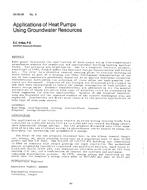The actual heating load of a building often differs from the designed load. One reason for this is the uncontrolled ventilation through a building envelope. Leakage flow rates can nowadays be predicted rather well, but the actual heating load of air infiltration has not been studied. It has, in practice, been calculated according to the predicted leakage flow rate and the temperature difference of the inside and outside air. The effect of leakage flows on the thermal behavior of building components (heat recovery effect) has been omitted.
According to our computer simulation, the warming of leakage air may be as high as 90% of the outdoor and indoor air temperature difference; Correspondingly, the Nusselt numbers describing the average relative reduction of transmission heat flux at the outer surface of the building envelope can be even 0.65. Therefore, it is suggested that in heat demand calculations, the value of transmission heat losses should be corrected, multiplying it by the Nusselt number, if the heat load of infiltration is calculated from the temperature difference of the indoor and outdoor air.
Leakage flows also affect the dynamic behavior of wall structures. The response factors for the inner surface heat flux and inflow temperature of leakage air are given for one wall structure. The response factors of the leakage flow rate are time-dependent, which rises from the non-linear thermal interaction of the airflow and wall structure.
A seasonal energy consumption was calculated for a building having leakage routes of two kinds. For a two-week period, the effect of heat recovery effect was 12-15%.
Units: SI
Citation: Symposium, ASHRAE Transactions, 1987, vol. 93, pt. 2, Nashville, TN
Product Details
- Published:
- 1987
- Number of Pages:
- 16
- File Size:
- 1 file , 1.3 MB
- Product Code(s):
- D-NT-87-27-3


